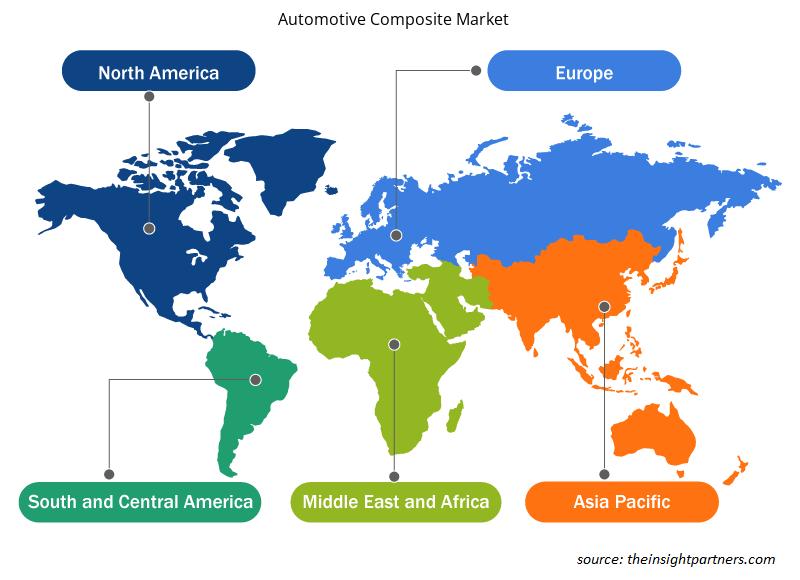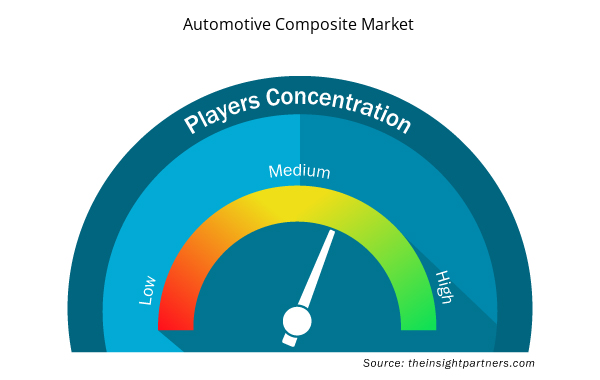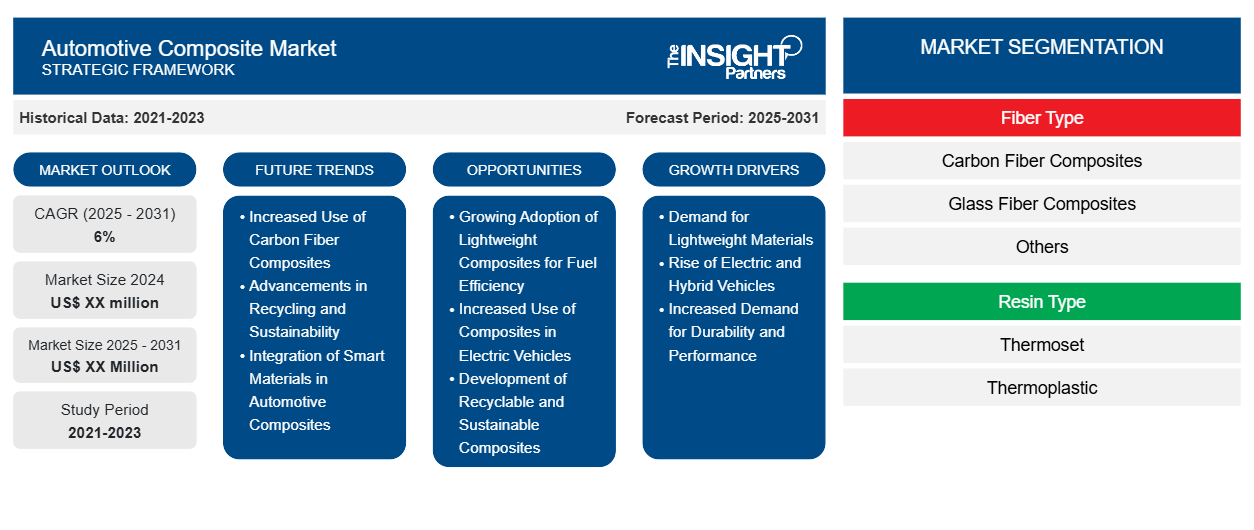Si prevede che il mercato dei materiali compositi per l'automotive registrerà un CAGR del 6% dal 2023 al 2031, con una dimensione di mercato in espansione da XX milioni di dollari nel 2023 a XX milioni di dollari entro il 2031.
Il report è segmentato per tipo di fibra (compositi in fibra di carbonio, compositi in fibra di vetro e altri). Il report presenta inoltre un'analisi basata su tipo di resina [termoindurente (poliestere, estere vinilico, epossidico, poliuretano e altri), termoplastica (polipropilene, polietilene, cloruro di polivinile, polistirene, polietilene tereftalato, policarbonato e altri)]. In base al tipo di veicolo, il report è segmentato in (veicoli passeggeri, veicoli commerciali leggeri (LCV), veicoli commerciali pesanti e veicoli a due ruote e altri). L'analisi globale è ulteriormente suddivisa a livello regionale e nei principali paesi. Il report offre il valore in USD per l'analisi e i segmenti di cui sopra.
Scopo del rapporto
Il report Automotive Composite Market di The Insight Partners mira a descrivere il panorama attuale e la crescita futura, i principali fattori trainanti, le sfide e le opportunità. Ciò fornirà spunti a vari stakeholder aziendali, come:
- Fornitori/produttori di tecnologia: per comprendere le dinamiche di mercato in evoluzione e conoscere le potenziali opportunità di crescita, consentendo loro di prendere decisioni strategiche informate.
- Investitori: condurre un'analisi completa delle tendenze in merito al tasso di crescita del mercato, alle proiezioni finanziarie del mercato e alle opportunità esistenti lungo la catena del valore.
- Enti di regolamentazione: regolamentano le politiche e le attività di controllo sul mercato allo scopo di ridurre al minimo gli abusi, preservare la fiducia degli investitori e sostenere l'integrità e la stabilità del mercato.
Segmentazione del mercato dei compositi per l'automotive
Tipo di fibra
- Compositi in fibra di carbonio
- Compositi in fibra di vetro
- Altri
Tipo di resina
- Termoindurente
- Termoplastico
Personalizza questo report in base alle tue esigenze
Riceverai la personalizzazione gratuita di qualsiasi report, comprese parti di questo report, o analisi a livello nazionale, pacchetto dati Excel, oltre a usufruire di grandi offerte e sconti per start-up e università
- Scopri le principali tendenze di mercato in questo rapporto.Questo campione GRATUITO includerà analisi di dati che spaziano dalle tendenze di mercato alle stime e alle previsioni.
Fattori trainanti della crescita del mercato dei materiali compositi per l'automotive
- Domanda di materiali leggeri: l'industria automobilistica è sempre più focalizzata sulla riduzione del peso dei veicoli per migliorare l'efficienza del carburante e ridurre le emissioni. I compositi per l'automotive, come le plastiche rinforzate con fibra di carbonio e i compositi in fibra di vetro, offrono soluzioni leggere senza compromettere resistenza e durata. Il loro utilizzo nei pannelli della carrozzeria, nei telai e negli interni sta accelerando.
- Ascesa dei veicoli elettrici e ibridi: la crescente popolarità dei veicoli elettrici (EV) e dei veicoli ibridi, che richiedono materiali leggeri per massimizzare le prestazioni e l'autonomia della batteria, sta guidando la domanda di compositi per l'automotive. Questi materiali aiutano a migliorare l'efficienza energetica complessiva, offrendo rapporti resistenza-peso migliorati.
- Maggiore richiesta di durata e prestazioni: i compositi per l'automotive sono noti per la loro durata, resistenza alla corrosione e capacità di sopportare condizioni ambientali difficili. Man mano che i veicoli diventano più avanzati tecnologicamente, la necessità di materiali che offrano elevate prestazioni pur essendo leggeri, resistenti alla corrosione e convenienti continua a crescere.
Tendenze future del mercato dei compositi per l'automotive
- Maggiore utilizzo di compositi in fibra di carbonio: poiché le case automobilistiche si concentrano sul miglioramento dell'efficienza del carburante e sulla riduzione del peso dei veicoli, si prevede che i compositi in fibra di carbonio diventeranno più diffusi. Questi materiali offrono significativi rapporti resistenza/peso, migliorando le prestazioni del veicolo e l'efficienza energetica, in particolare nei veicoli elettrici, nelle auto di lusso e nei veicoli sportivi ad alte prestazioni.
- Progressi nel riciclaggio e nella sostenibilità: il futuro dei compositi per l'automotive vedrà un focus sul miglioramento della riciclabilità dei materiali compositi. Lo sviluppo di materiali compositi più facili da riciclare e più sostenibili guiderà la crescita nel settore automobilistico, poiché le preoccupazioni ambientali e la riduzione dei rifiuti diventeranno più critiche.
- Integrazione di materiali intelligenti nei compositi per l'automotive: si prevede che l'ascesa dei compositi intelligenti con proprietà auto-riparanti, sensori e altre funzionalità integrate rivoluzionerà l'industria automobilistica. Questi materiali consentiranno ai veicoli di monitorare le loro condizioni, riparare piccoli danni e migliorare le prestazioni complessive del veicolo, portando a una maggiore durata e a costi di manutenzione ridotti.
Opportunità di mercato dei compositi per l'automotive
- Crescente adozione di compositi leggeri per l'efficienza del carburante: poiché le case automobilistiche si concentrano sul miglioramento dell'efficienza del carburante, i compositi leggeri, come la fibra di carbonio e la fibra di vetro, rappresentano un'opportunità di mercato chiave. Questi materiali vengono integrati nelle parti della carrozzeria, nel telaio e nei componenti interni dei veicoli per ridurre il peso, migliorare le prestazioni e soddisfare gli obiettivi normativi sulle emissioni.
- Maggiore utilizzo di materiali compositi nei veicoli elettrici: il passaggio ai veicoli elettrici (EV) offre opportunità significative per il mercato dei materiali compositi per l'automotive. I veicoli elettrici richiedono materiali leggeri per massimizzare l'autonomia e l'efficienza della batteria, e i materiali compositi sono ideali per questo scopo. Con l'aumento della produzione di veicoli elettrici, aumenterà anche la domanda di materiali compositi avanzati in settori quali alloggiamenti per batterie, componenti strutturali ed elementi interni.
- Sviluppo di compositi riciclabili e sostenibili: con la crescente enfasi sulla sostenibilità, c'è un mercato in crescita per i compositi automobilistici riciclabili ed eco-compatibili. I produttori stanno innovando con compositi di origine biologica e materiali riciclabili, che possono soddisfare sia i requisiti prestazionali che quelli ambientali, presentando un'opportunità redditizia nel settore automobilistico verde.
Approfondimenti regionali sul mercato dei compositi per l'automotive
Le tendenze regionali e i fattori che influenzano il mercato dei compositi per l'automotive durante il periodo di previsione sono stati ampiamente spiegati dagli analisti di Insight Partners. Questa sezione discute anche i segmenti e la geografia del mercato dei compositi per l'automotive in Nord America, Europa, Asia Pacifico, Medio Oriente e Africa, e Sud e Centro America.

- Ottieni i dati specifici regionali per il mercato dei compositi automobilistici
Ambito del rapporto sul mercato dei compositi per l'automotive
| Attributo del report | Dettagli |
|---|---|
| Dimensioni del mercato nel 2023 | XX milioni di dollari USA |
| Dimensioni del mercato entro il 2031 | XX milioni di dollari USA |
| CAGR globale (2023-2031) | 6% |
| Dati storici | 2021-2022 |
| Periodo di previsione | 2024-2031 |
| Segmenti coperti | Per tipo di fibra
|
| Regioni e Paesi coperti | America del Nord
|
| Leader di mercato e profili aziendali chiave |
|
Densità dei player del mercato dei compositi per l'automotive: comprendere il suo impatto sulle dinamiche aziendali
Il mercato Automotive Composite Market sta crescendo rapidamente, spinto dalla crescente domanda degli utenti finali dovuta a fattori quali l'evoluzione delle preferenze dei consumatori, i progressi tecnologici e una maggiore consapevolezza dei vantaggi del prodotto. Con l'aumento della domanda, le aziende stanno ampliando le loro offerte, innovando per soddisfare le esigenze dei consumatori e capitalizzando sulle tendenze emergenti, il che alimenta ulteriormente la crescita del mercato.
La densità degli operatori di mercato si riferisce alla distribuzione di aziende o società che operano in un particolare mercato o settore. Indica quanti concorrenti (operatori di mercato) sono presenti in un dato spazio di mercato in relazione alle sue dimensioni o al valore di mercato totale.
Le principali aziende che operano nel mercato dei materiali compositi per l'automotive sono:
- Azienda
- Carbonio SGL
- TEIJIN LIMITATA
- Società chimica Mitsubishi.
- Società Hexcel
Disclaimer : le aziende elencate sopra non sono classificate secondo un ordine particolare.

- Ottieni una panoramica dei principali attori del mercato dei compositi per l'automotive
Punti chiave di vendita
- Copertura completa: il rapporto affronta in modo completo l'analisi di prodotti, servizi, tipologie e utenti finali del mercato dei materiali compositi per l'automotive, fornendo una panoramica olistica.
- Analisi degli esperti: il rapporto è compilato sulla base della conoscenza approfondita di esperti e analisti del settore.
- Informazioni aggiornate: il rapporto garantisce la pertinenza aziendale grazie alla copertura di informazioni recenti e tendenze nei dati.
- Opzioni di personalizzazione: questo report può essere personalizzato per soddisfare le esigenze specifiche del cliente e adattarsi in modo appropriato alle strategie aziendali.
Il rapporto di ricerca sul mercato dei compositi per l'automotive può quindi aiutare a guidare il percorso di decodifica e comprensione dello scenario del settore e delle prospettive di crescita. Sebbene possano esserci alcune preoccupazioni valide, i vantaggi complessivi di questo rapporto tendono a superare gli svantaggi.
- Analisi storica (2 anni), anno base, previsione (7 anni) con CAGR
- Analisi PEST e SWOT
- Valore/volume delle dimensioni del mercato - Globale, regionale, nazionale
- Industria e panorama competitivo
- Set di dati Excel



Report Coverage
Revenue forecast, Company Analysis, Industry landscape, Growth factors, and Trends

Segment Covered
This text is related
to segments covered.

Regional Scope
North America, Europe, Asia Pacific, Middle East & Africa, South & Central America

Country Scope
This text is related
to country scope.
Domande frequenti
DuPont de Nemours Inc, Gurit Holding AG, Hexion Inc, Mitsubishi Chemical Holdings Corp, Nippon Electric Glass Co Ltd, Owens Corning are some of the key players operating in the automotive composites market
Based on geography, Asia Pacific held the largest share of the automotive composites market due to the well-established automotive industry across the region
Increased use of carbon fiber composites is expected to be the key market trends.
Based on fiber type, the carbon fiber segment is expected to witness the fastest growth during the forecast period
The Automotive Composite Market is estimated to witness a CAGR of 12.0% from 2025 to 2031
Demand for lightweight materials is driving the automotive composites market growth.
Trends and growth analysis reports related to Chemicals and Materials : READ MORE..
The List of Companies
- Toray Industries Inc.
- SGL Carbon
- TEIJIN LIMITED
- Mitsubishi Chemical Corporation.
- Hexcel Corporation
- John Manville Corporation
- Owens Corning
- Zoltek Carbon Fiber
- Cytec Solvay Group
- Gurit
The Insight Partners performs research in 4 major stages: Data Collection & Secondary Research, Primary Research, Data Analysis and Data Triangulation & Final Review.
- Data Collection and Secondary Research:
As a market research and consulting firm operating from a decade, we have published and advised several client across the globe. First step for any study will start with an assessment of currently available data and insights from existing reports. Further, historical and current market information is collected from Investor Presentations, Annual Reports, SEC Filings, etc., and other information related to company’s performance and market positioning are gathered from Paid Databases (Factiva, Hoovers, and Reuters) and various other publications available in public domain.
Several associations trade associates, technical forums, institutes, societies and organization are accessed to gain technical as well as market related insights through their publications such as research papers, blogs and press releases related to the studies are referred to get cues about the market. Further, white papers, journals, magazines, and other news articles published in last 3 years are scrutinized and analyzed to understand the current market trends.
- Primary Research:
The primarily interview analysis comprise of data obtained from industry participants interview and answers to survey questions gathered by in-house primary team.
For primary research, interviews are conducted with industry experts/CEOs/Marketing Managers/VPs/Subject Matter Experts from both demand and supply side to get a 360-degree view of the market. The primary team conducts several interviews based on the complexity of the markets to understand the various market trends and dynamics which makes research more credible and precise.
A typical research interview fulfils the following functions:
- Provides first-hand information on the market size, market trends, growth trends, competitive landscape, and outlook
- Validates and strengthens in-house secondary research findings
- Develops the analysis team’s expertise and market understanding
Primary research involves email interactions and telephone interviews for each market, category, segment, and sub-segment across geographies. The participants who typically take part in such a process include, but are not limited to:
- Industry participants: VPs, business development managers, market intelligence managers and national sales managers
- Outside experts: Valuation experts, research analysts and key opinion leaders specializing in the electronics and semiconductor industry.
Below is the breakup of our primary respondents by company, designation, and region:

Once we receive the confirmation from primary research sources or primary respondents, we finalize the base year market estimation and forecast the data as per the macroeconomic and microeconomic factors assessed during data collection.
- Data Analysis:
Once data is validated through both secondary as well as primary respondents, we finalize the market estimations by hypothesis formulation and factor analysis at regional and country level.
- Macro-Economic Factor Analysis:
We analyse macroeconomic indicators such the gross domestic product (GDP), increase in the demand for goods and services across industries, technological advancement, regional economic growth, governmental policies, the influence of COVID-19, PEST analysis, and other aspects. This analysis aids in setting benchmarks for various nations/regions and approximating market splits. Additionally, the general trend of the aforementioned components aid in determining the market's development possibilities.
- Country Level Data:
Various factors that are especially aligned to the country are taken into account to determine the market size for a certain area and country, including the presence of vendors, such as headquarters and offices, the country's GDP, demand patterns, and industry growth. To comprehend the market dynamics for the nation, a number of growth variables, inhibitors, application areas, and current market trends are researched. The aforementioned elements aid in determining the country's overall market's growth potential.
- Company Profile:
The “Table of Contents” is formulated by listing and analyzing more than 25 - 30 companies operating in the market ecosystem across geographies. However, we profile only 10 companies as a standard practice in our syndicate reports. These 10 companies comprise leading, emerging, and regional players. Nonetheless, our analysis is not restricted to the 10 listed companies, we also analyze other companies present in the market to develop a holistic view and understand the prevailing trends. The “Company Profiles” section in the report covers key facts, business description, products & services, financial information, SWOT analysis, and key developments. The financial information presented is extracted from the annual reports and official documents of the publicly listed companies. Upon collecting the information for the sections of respective companies, we verify them via various primary sources and then compile the data in respective company profiles. The company level information helps us in deriving the base number as well as in forecasting the market size.
- Developing Base Number:
Aggregation of sales statistics (2020-2022) and macro-economic factor, and other secondary and primary research insights are utilized to arrive at base number and related market shares for 2022. The data gaps are identified in this step and relevant market data is analyzed, collected from paid primary interviews or databases. On finalizing the base year market size, forecasts are developed on the basis of macro-economic, industry and market growth factors and company level analysis.
- Data Triangulation and Final Review:
The market findings and base year market size calculations are validated from supply as well as demand side. Demand side validations are based on macro-economic factor analysis and benchmarks for respective regions and countries. In case of supply side validations, revenues of major companies are estimated (in case not available) based on industry benchmark, approximate number of employees, product portfolio, and primary interviews revenues are gathered. Further revenue from target product/service segment is assessed to avoid overshooting of market statistics. In case of heavy deviations between supply and demand side values, all thes steps are repeated to achieve synchronization.
We follow an iterative model, wherein we share our research findings with Subject Matter Experts (SME’s) and Key Opinion Leaders (KOLs) until consensus view of the market is not formulated – this model negates any drastic deviation in the opinions of experts. Only validated and universally acceptable research findings are quoted in our reports.
We have important check points that we use to validate our research findings – which we call – data triangulation, where we validate the information, we generate from secondary sources with primary interviews and then we re-validate with our internal data bases and Subject matter experts. This comprehensive model enables us to deliver high quality, reliable data in shortest possible time.


 Ottieni un campione gratuito per questo repot
Ottieni un campione gratuito per questo repot